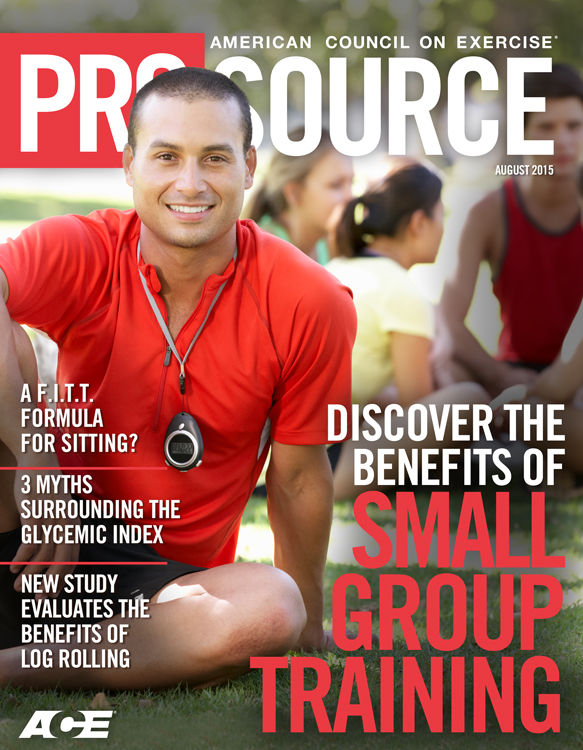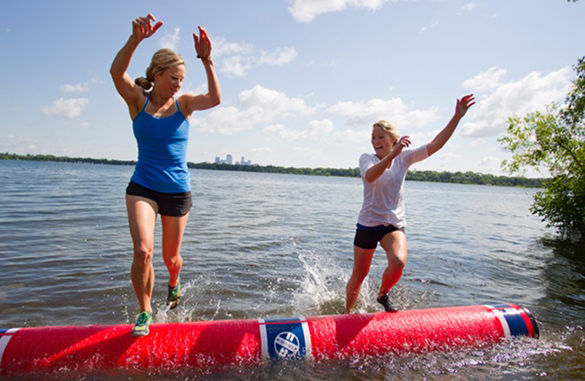
For much of the country, log rolling is something you might stumble across on ESPN3 at 2:00 in the morning. But for those in the Upper Midwest, log rolling is a popular family recreational activity and a cherished historical event that began as a necessary workplace skill for the region’s loggers. The pinnacle of competition takes place each year at the Lumberjack World Championship in Hayward, Wis.
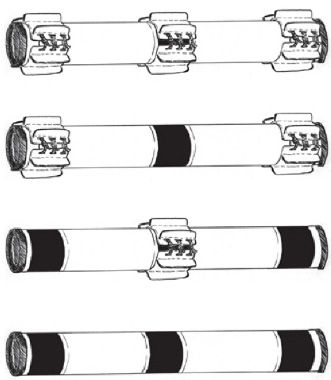
The Key Log has three trainer “paddles” that can be added/removed to decrease or increase the speed at which the log can be rolled.
Log rolling has traditionally been done on machine-lathed red cedar logs that often weigh in excess of 250 pounds. In an effort to make log rolling more accessible to the general public, the Key Log Rolling Company developed a synthetic log, which weighs 65 pounds when empty but can be filled with water to equal the weight of a traditional log. This ingenious product—called the Key Log—also has three removable “paddles” to govern rolling speed, making it easier for a beginner to control the intensity and learn the proper techniques of the sport.
The Key Log has three trainer “paddles” that can be added/removed to decrease or increase the speed at which the log can be rolled.
John P. Porcari, Ph.D., and his team of researchers at the University of Wisconsin – La Crosse set out to determine the relative exercise intensity and caloric expenditure of log rollers using the Key Log and compare those responses to those of rollers using a traditional cedar log.
The Study
The subjects for this study were 19 apparently healthy log rollers between 17 and 61 years of age. Skill levels of the log rollers ranged from novice to elite. To participate, “novice rollers” had to be able to roll on a Key Log for a minimum of three minutes without falling off. This duration is approximately the minimum time required to achieve a metabolic steady-state using respiratory gas analysis. Log rollers capable of competing at the Lumberjack World Championships were categorized as “elite rollers.”

Prior to testing, novice log rollers were allowed enough practice to meet the minimal rolling criteria. During testing, subjects were fitted with a heart-rate monitor and connected via a boom system to a metabolic analyzer, which collected and analyzed expired air.
Log rollers used either a synthetic Key Log fitted with removable paddles or a traditional cedar log that was 14 inches in diameter and weighed approximately 250 pounds. Depending on their ability, subjects completed up to seven rounds of log rolling, each of which lasted from three to seven minutes based on the time it took for the oxygen consumption (VO2) data to reach a steady state.
The seven rolling conditions involved using the Key Log with three, two, one or zero paddles; using the Key Log against a competitor; using the cedar log; and using the cedar log against a competitor. Upon completion of each round of rolling, heart rate (HR) was recorded and subjects were asked to provide ratings of perceived exertion (RPE) using the 6–20 Borg scale.
The Results
Table 1 presents the responses of elite and novice log rollers using the Key Log with a varying number of paddles in place. What this shows is that while there was no significant difference in HR between elite and novice log rollers at any rolling speed, there was a trend for VO2 and caloric expenditure (kcal/min) to be higher in novice rollers. As Maria Cress, the lead author of this study, explains, “Elite rollers have improved technique and coordination and a stronger sense of the center of gravity and proprioception, while novice rollers are not as efficient. You often see beginners swinging their arms and making dramatic compensations to maintain their balance.” Stated simply, beginners work harder just to stay on the log. RPE was also higher for novice rollers, but only significantly so when using the log with three paddles.
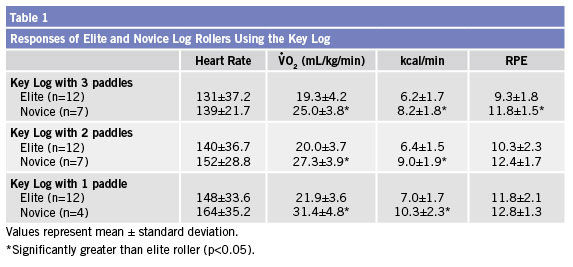
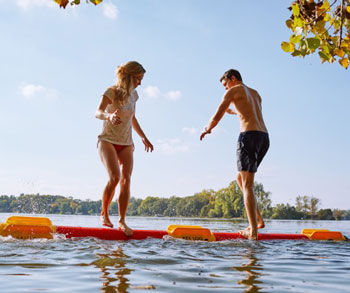
Responses of elite log rollers using the Key Log and cedar log are summarized in Table 2. There were no significant differences in HR between rolling on the Key Log and the cedar log, with or without an opponent. There were also no significant differences in VO2, caloric expenditure or RPE between rollers using the Key Log and those using the cedar log when rolling against an opponent. However, VO2, caloric expenditure and RPE were significantly greater for rollers using the cedar log compared to the Key Log when rolling without an opponent. In the latter scenario, differences in VO2 could be due to the size of the log. In this study, a 14-inch diameter cedar log was compared to the Key Log, which has a 15-inch diameter. The size difference may have allowed the cedar log to sit lower in the water and spin faster than the Key Log, making it more difficult to roll on a cedar log.
Cress explains that rolling with and without an opponent can be very different experiences and offer different challenges. Rolling against an opponent is largely about control and strength while transitioning between forward and backward rolling. Log rolling alone is almost entirely about speed.
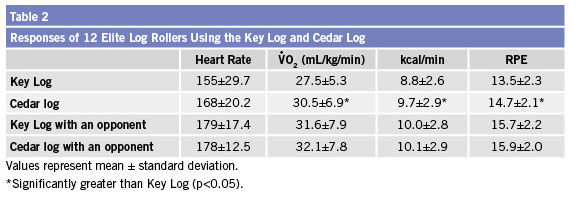
The Bottom Line
“Log rolling proved to be more taxing than we’d envisioned in terms of intensity and caloric expenditure,” explains Dr. Porcari. The results of this study indicate that rolling on the Key Log meets established fitness industry standards for improving cardiorespiratory endurance and can be considered both a moderate and vigorous form of exercise depending on how many paddles were used (ACSM, 2014).
Metabolic equivalents (METs) are often used to determine the intensity of exercise. A MET level of 3 to 6 is considered a moderate-intensity activity and greater than 6 is considered vigorous activity (ACSM, 2014). Elite log rollers, when rolling against an opponent, reached a 9 MET energy-expenditure level, which is equivalent to swimming vigorously or jogging at 5.5 mph. Novice rollers using three paddles on the Key Log reached a 7 MET level, which is equivalent to hiking at a moderate pace or bicycling at 12 to 14 miles per hour. Both levels meet the criteria necessary to be considered a vigorous activity, regardless of rolling skill.
The goal of the makers of the Key Log is to help log rolling move beyond the Upper Midwest to become a fun recreational activity across the country. Dr. Porcari supports this notion. “Log rolling presents fun challenge that builds balance and coordination, as well as overall fitness.” Sounds like it’s time to get rolling!
Reference
American College of Sports Medicine (2014). ACSM’s Guidelines for Exercise Testing and Prescription (9th ed.). Philadelphia: Wolters Kluwer/Lippincott Williams & Wilkins.
This study was funded by a University of Wisconsin-La Crosse Graduate Student Research, Service and Educational Leadership (RSEL) grant.





